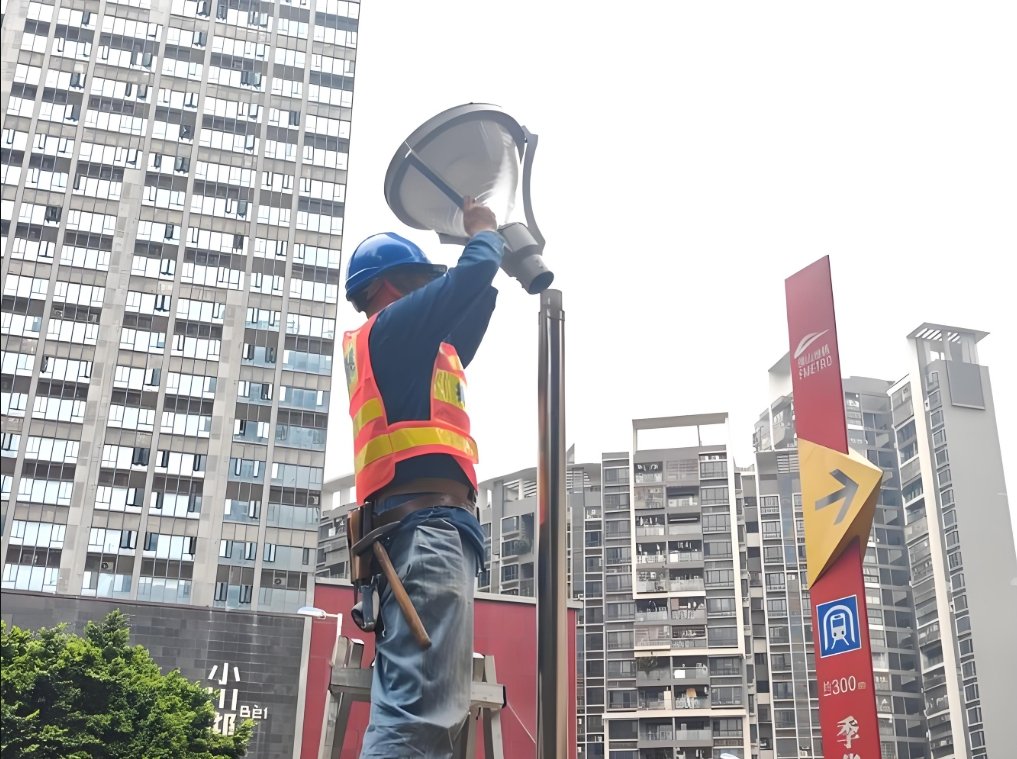Common Outdoor Lighting Issues and Maintenance Tips
1. Introduction
Outdoor lighting plays a critical role in enhancing the security, functionality, and aesthetics of both residential and commercial spaces. From illuminating pathways to highlighting landscaping and providing safety at night, proper outdoor lighting is essential for any property. However, like all systems, outdoor lighting requires regular maintenance to function optimally.
The common problems with outdoor lighting include flickering, complete power failure, moisture issues, dimming, and wiring problems. Regular maintenance ensures that outdoor lighting systems remain operational and safe, while also extending their lifespan.
This guide is aimed at helping procurement officers, facility managers, and maintenance teams identify common outdoor lighting issues and perform the necessary maintenance to ensure long-lasting, high-performance lighting systems.

2. What are the problems with outdoor lighting?
2.1. Flickering or Inconsistent Lighting
Causes:
Flickering lights can occur due to various factors, such as loose wiring, a failing LED driver, or poor-quality components. If these issues are not addressed, they may lead to a complete system failure.
Impact:
Inconsistent lighting creates visibility issues and can pose safety risks in areas where lighting is critical, such as parking lots, pathways, or outdoor security zones.
Solution:
Regularly inspect wiring and LED drivers for any signs of wear or failure. Ensure that components used are of high quality and consider upgrading to modular systems for ease of maintenance and replacement.
2.2. Complete Failure or No Power
Causes:
This problem may arise due to a circuit failure, blown fuses, or issues with the LED driver, all of which can prevent lights from turning on.
Impact:
Power failure in outdoor lighting can result in loss of illumination in critical areas, exposing the property to security vulnerabilities and unsafe conditions.
Solution:
Test the system with a multimeter to diagnose the issue. Identify faulty drivers or power supply problems and replace them promptly to restore full functionality.
2.3. Water Ingress and Moisture Problems
Causes:
Outdoor lighting fixtures are exposed to the elements, and if the IP rating is insufficient, water can enter the fixture, leading to corrosion, electrical shorts, and component damage.
Impact:
Moisture within fixtures can significantly affect their performance and lifespan. In extreme cases, it can cause the system to fail completely.
Solution:
Ensure that all fixtures are properly sealed and rated for the specific environmental conditions they will face (e.g., IP65 for outdoor use). Use weatherproofing solutions like silicone sealants to protect vulnerable areas.
2.4. Dimming or Reduced Brightness
Causes:
Over time, LED chips degrade, and dust can accumulate on the fixtures, causing reduced brightness. Aging drivers can also affect the performance of the lights.
Impact:
Dimming lights can reduce visibility and may lead to non-compliance with safety or aesthetic requirements.
Solution:
Regular cleaning of fixtures will help maintain optimal light output. If the dimming persists, consider replacing aged drivers or LED modules to restore full brightness.
2.5. Wiring Issues and Safety Hazards
Causes:
Exposed, frayed, or damaged wiring is one of the most common issues with outdoor lighting systems, and it can be caused by animals, plants, or general wear and tear.
Impact:
Damaged wiring can pose serious safety risks, including the risk of electrical fires or malfunctioning lights. It is crucial to address these issues immediately.
Solution:
Inspect all wiring for any signs of damage, and replace or repair any frayed wires or loose connections. Ensure that all outdoor lighting is properly grounded and shielded from the environment.

3. What is the maintenance of outdoor lighting systems?
3.1. Troubleshooting and Diagnostic Techniques
Proper maintenance of outdoor lighting systems involves regular troubleshooting to identify any early signs of wear or failure. Here’s how you can effectively troubleshoot:
- Step-by-Step Troubleshooting: Inspect electrical connections, LED modules, and power supplies for any signs of damage. Use tools like multimeters to check for electrical issues and thermal cameras to detect heat spots that may indicate a failing component.
- Professional Assistance: While routine maintenance can be handled in-house, complex issues such as driver failures, severe electrical problems, or large-scale system repairs should be addressed by certified professionals.
3.2. Preventive Maintenance Tips
3.2.1. Regular Cleaning
Procedure:
- Turn off the power before starting the cleaning process.
- Use a soft cloth to remove dirt, dust, and debris from the light fixtures and lenses.
- For heavy soiling, dampen the cloth with water and mild soap to clean the fixtures.
- Avoid harsh chemicals that could damage the finish.
Importance:
Cleaning helps maintain optimal light output, prevents corrosion, and extends the lifespan of the fixtures.
3.2.2. Trim Surrounding Vegetation
Importance:
Plants and trees can obstruct the light output or damage the fixtures over time. Ensure that vegetation around your outdoor lights is trimmed regularly.
Best Practices:
- Regularly inspect the area surrounding the fixtures for overgrown plants, branches, or vines.
- Trim any plant matter that could obstruct the light or cause damage to wiring.
3.2.3. Check for Moisture and Corrosion
Solution:
- Inspect the fixtures for signs of water ingress. If there are any visible signs of moisture, replace the affected parts immediately.
- Use IP-rated fixtures to protect against water and ensure long-lasting performance.
3.2.4. Upgrade to Energy-Efficient LED Bulbs
Benefits:
- LED lights have a longer lifespan and consume less power than traditional incandescent bulbs.
- Upgrading to energy-efficient bulbs reduces maintenance and operational costs.
Recommendation:
Consider upgrading older fixtures to modular LED systems for better reliability and ease of maintenance.

4. How to maintain outdoor light fixtures?
- Regular Inspection: Perform periodic checks of your outdoor light fixtures to ensure that all components (wiring, casings, seals) are intact.
- Cleaning: Regularly clean fixtures to remove dirt and prevent buildup that could degrade the light quality.
- Repairs and Replacements: Address any component failures immediately to avoid further damage and ensure reliable operation.
5. What is the rule of thumb for outdoor lighting?
- Proper Placement: Ensure that your lights are positioned to maximize coverage and avoid obstructions.
- Regular Maintenance: A proactive maintenance schedule is essential. Aim for quarterly inspections and cleaning to keep the lighting system in top shape.
- Upgrade to Durable Systems: Invest in high-quality, IP-rated fixtures that are designed to withstand harsh weather conditions, reducing the need for frequent repairs.
6. Working with Reliable Manufacturers and Suppliers
- Choosing the Right Supplier: Always choose outdoor lighting products that are backed by certifications (e.g., CE, RoHS) and come with a warranty.
- Importance of Modular Design: Fixtures with modular designs are easier to maintain and replace, saving time and money.
- Long-Term Supplier Relationships: Establish long-term relationships with trusted suppliers to ensure timely access to spare parts and maintenance support.
7. Repair vs. Replacement: When to Choose
- Cost-Benefit Analysis: Sometimes, it’s more cost-effective to replace rather than repair an aging system. Evaluate the overall condition and lifespan of the fixtures before making a decision.
- Lifespan Considerations: Regularly track the lifespan of your lighting components (such as LED chips and drivers) to determine when they need to be replaced.
8. Conclusion
Effective outdoor lighting maintenance is crucial for keeping your system functional and reliable. Regular upkeep helps avoid costly downtime and enhances security, making your property safer and more attractive.
By following the maintenance tips outlined in this guide, you can prolong the life of your outdoor lighting system, reduce operational costs, and ensure that your lighting performs at its best for years to come.

